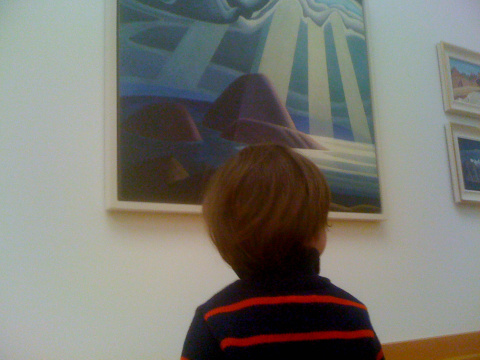
« PREVIOUS ENTRY
The science of surviving a zombie invasion

I wasn’t supposed to take this picture.
Here’s the backdrop: Last week I was in Toronto for the holidays, visiting family and friends, and I decided to take my four-year-old son Gabriel and two-year-old son Zev to the Art Gallery of Ontario to see works by the Group of Seven. Zev was pretty entranced by the Lawren Harris paintings — that’s him above, checking out one of Harris’ works. (I didn’t note the name of that painting; does anyone know?)
Though I’ve always enjoyed the Group of Seven’s work, I hadn’t actually been face-to-face with any of the paintings for ten years or so. I had forgotten how totally awesome they remain, decades after their work ceased being revolutionary or “new”. When I was a kid, my favorite was Harris, because his Arctic paintings — all the icebergs and snowy mountains — were so straightforwardly iconic and ethereal, almost comic-booky. But I never really appreciated the way Harris put traditional Judeo-Christian iconography into a blender with First-Nations artistic traditions.
I also found myself completely absorbed in the other Group of Seven members I hadn’t paid much attention to before, like Franklin Carmichael. Interestingly, I think this is because I’d been admiring the recent “fauxvist” video-game paintings of my friend James Barnett. And Carmichael himself — like most of the Group of Seven — was also inspired by the fauvists, to the point where Carmichael’s “Autumn in the Northland” looks a lot like Jamie’s paintings, and vice versa. (If you haven’t read my blog post about Jamie’s video-game paintings, go see it now so the rest of this blog post will make sense.) When I first saw Jamie’s paintings back last summer, I went online and read a bunch of art criticism about the fauvists, because I was intrigued by how Jamie was using their technique to do create video-game landscape art. By the time I hit the Art Gallery of Ontario two weeks ago, I was much more able to appreciate Carmichael’s work, since he was doing the same thing a hundred years ago — using fauvist techniques to re-see the Canadian wilderness. This whole process became a most excellent cultural-feedback loop: The fauvists inspire Jamie, who does paintings of video games in that style, which gets me interested in the fauvists, which allows me to re-appreciate the revolutions in Canadian art that were triggered a century ago during the actual time of the fauvists.
It reminded me of a point often made by folks who fight overly-aggressive copyright laws: All new art is based on art that came before, so copyright law ought not to be too rigid. If you can’t remix and resample and re-use art — after a reasonable term of exclusivity for the original creators, who in this case are long dead — then culture dies. More subtly yet, our appreciation for earlier art dies if our contemporary artists cannot easily plunder the styles and content of their forebears.
The irony here is that the instant after I snapped this picture, the security guards of the Art Gallery of Ontario raced over to (politely) warn me that I wasn’t allowed to take pictures. Why? Well, some art galleries disallow photos because flashes can damage paintings, a prohibition that makes total sense. But my iPhone doesn’t have a flash. No, the Art Gallery of Ontario prohibits photographs of artwork because of copyright restrictions. The AGO folks don’t sound very happy about this (“We didn’t set the copyright rules but we are required to respect them,” as they point out on their site). It’s even more daft when you consider that I’m basically doing free promotion here.You want people to visit galleries? Well, surely one good way is to let visitors take and post photos of their little kids spellbound by major works of art.
Ah well. My line of logic here is, I admit, rather loose and rambling. Jamie’s video-game paintings do not actually impinge on any copyright from earlier paintings; they’re using the style of a former generation of artists, not their specific content. Still, the whole thing made me think a lot about the way art builds on art — and how copyright law can actually get in the way of art appreciation.
I'm Clive Thompson, the author of Smarter Than You Think: How Technology is Changing Our Minds for the Better (Penguin Press). You can order the book now at Amazon, Barnes and Noble, Powells, Indiebound, or through your local bookstore! I'm also a contributing writer for the New York Times Magazine and a columnist for Wired magazine. Email is here or ping me via the antiquated form of AOL IM (pomeranian99).

ECHO
Erik Weissengruber
Vespaboy
Terri Senft
Tom Igoe
El Rey Del Art
Morgan Noel
Maura Johnston
Cori Eckert
Heather Gold
Andrew Hearst
Chris Allbritton
Bret Dawson
Michele Tepper
Sharyn November
Gail Jaitin
Barnaby Marshall
Frankly, I'd Rather Not
The Shifted Librarian
Ryan Bigge
Nick Denton
Howard Sherman's Nuggets
Serial Deviant
Ellen McDermott
Jeff Liu
Marc Kelsey
Chris Shieh
Iron Monkey
Diversions
Rob Toole
Donut Rock City
Ross Judson
Idle Words
J-Walk Blog
The Antic Muse
Tribblescape
Little Things
Jeff Heer
Abstract Dynamics
Snark Market
Plastic Bag
Sensory Impact
Incoming Signals
MemeFirst
MemoryCard
Majikthise
Ludonauts
Boing Boing
Slashdot
Atrios
Smart Mobs
Plastic
Ludology.org
The Feature
Gizmodo
game girl
Mindjack
Techdirt Wireless News
Corante Gaming blog
Corante Social Software blog
ECHO
SciTech Daily
Arts and Letters Daily
Textually.org
BlogPulse
Robots.net
Alan Reiter's Wireless Data Weblog
Brad DeLong
Viral Marketing Blog
Gameblogs
Slashdot Games